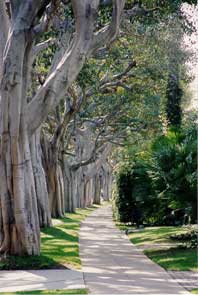 Trees clean the air. Tree foliage works as a natural air filter of particulate matter such as dust, micro sized metals and pollutants such as ozone, nitrogen oxides, ammonia and sulfur dioxides. Trees take in carbon dioxide and produce oxygen. Combined with the cooling effect of trees, these processes can have a significant impact on reducing smog and overall air pollution.
Trees clean the air. Tree foliage works as a natural air filter of particulate matter such as dust, micro sized metals and pollutants such as ozone, nitrogen oxides, ammonia and sulfur dioxides. Trees take in carbon dioxide and produce oxygen. Combined with the cooling effect of trees, these processes can have a significant impact on reducing smog and overall air pollution.
Trees improve water quality. A healthy urban forest can have a strong influence on our region’s water quality. Tree canopies and root systems slow and reduce storm water runoff, flooding and erosion. Trees also help filter water runoff reducing potential sources of water pollution into our rivers and storm drains.
Trees save energy. Trees cool the air naturally in two ways: through water evaporating from the leaves and direct shade. Homes shaded by trees need less energy for cooling which means lower monthly utility bills in summer and a reduced need for utilities to increase power generation to meet peak load demand.
Trees raise real estate value. Shaded neighborhoods and well-landscaped yards have a positive economic influence on real estate values, timeliness of house sales and neighborhood desirability. Studies report that landscaping speeds the sale of a home by four to six weeks.
From: www.sactree.com
Trees are good for business. A series of studies has investigated associations between the urban forest and people’s response to shopping settings. Scientific results suggest that having trees in the business district streetscape is an important investment for a business community. The presence of a quality urban forest positively influences shoppers’ perceptions, and probably, their behavior.
From: www.cfr.washington.edu
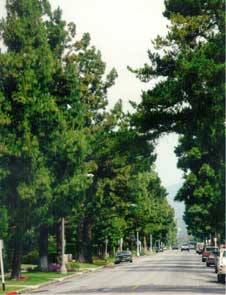 Trees help stop inner city violence. A scientific study by the Human-Environment Research Lab has demonstrated that contact with nature may actually help reduce the incidence of aggression and violence in inner-city neighborhoods. According to this study, levels of aggression were significantly lower among people who had some kind of nature outside of their apartments versus those who didn’t. The impact of the physical environment on human aggression has been well-established – crowding, high temperatures, and noise have all been linked to violent behavior. Some scientists believe that it’s because people living under these conditions suffer from something called chronic mental fatigue, which can make them inattentive, irritable, and impulsive – all of which can be linked to aggressive behavior. Exposure to green spaces, it has been shown, can mitigate the harmful effects of chronic mental fatigue, reducing aggressive behavior in the process.
Trees help stop inner city violence. A scientific study by the Human-Environment Research Lab has demonstrated that contact with nature may actually help reduce the incidence of aggression and violence in inner-city neighborhoods. According to this study, levels of aggression were significantly lower among people who had some kind of nature outside of their apartments versus those who didn’t. The impact of the physical environment on human aggression has been well-established – crowding, high temperatures, and noise have all been linked to violent behavior. Some scientists believe that it’s because people living under these conditions suffer from something called chronic mental fatigue, which can make them inattentive, irritable, and impulsive – all of which can be linked to aggressive behavior. Exposure to green spaces, it has been shown, can mitigate the harmful effects of chronic mental fatigue, reducing aggressive behavior in the process.
From: www.sactree.com
What is “the urban forest”?
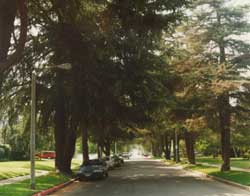 Trees that grow in cities and towns are called “the urban forest”. Trees are major capital assets in cities across the United States. Just as streets, sidewalks, public buildings and recreational facilities are a part of a community’s infrastructure, so are publicly owned trees. Trees — and, collectively, the urban forest — are important assets that require care and maintenance the same as other public property. Trees are on the job 24 hours every day working for all of us to improve our environment and quality of life. Life is hard for these trees because of limited space, water, nutrients and extensive pavement covering the soil all around them. Many trees get cut down because their roots crack the pavement as they seek water and nutrients. The urban forest (and its many benefits) will disappear unless people stand up for these trees and work to plant, maintain and steward them. Conscious urban forestry needs to become integrated into the agenda of all city governments and city planners.
Trees that grow in cities and towns are called “the urban forest”. Trees are major capital assets in cities across the United States. Just as streets, sidewalks, public buildings and recreational facilities are a part of a community’s infrastructure, so are publicly owned trees. Trees — and, collectively, the urban forest — are important assets that require care and maintenance the same as other public property. Trees are on the job 24 hours every day working for all of us to improve our environment and quality of life. Life is hard for these trees because of limited space, water, nutrients and extensive pavement covering the soil all around them. Many trees get cut down because their roots crack the pavement as they seek water and nutrients. The urban forest (and its many benefits) will disappear unless people stand up for these trees and work to plant, maintain and steward them. Conscious urban forestry needs to become integrated into the agenda of all city governments and city planners.
To learn more about Urban Forests please click here Networx
What is the value of a tree?
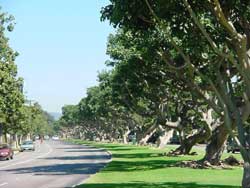 A tree can return up to $2.70 for each $1 on community investment…that’s a 270% return (based on a 40 year average life span according to Center for Urban Forest Research, Pacific Southwest Research Station, U.S. Forest Service, Davis, CA)
A tree can return up to $2.70 for each $1 on community investment…that’s a 270% return (based on a 40 year average life span according to Center for Urban Forest Research, Pacific Southwest Research Station, U.S. Forest Service, Davis, CA)
- Four trees planted around a home can save up to 30% on summer cooling costs.
- One million trees save $10 million a year in energy costs.
- Forty trees remove 80 pounds of air pollutants annually.
- Four million trees can save $20 million in air pollution clean up.
- Four hundred trees capture 140,000 gallons of rainwater annually.
- Four million trees save $14 million dollars in annual storm water runoff costs.
- Trees in commercial parking lots induce shoppers to spend 11% more for goods and services.
From: www.sactree.com
- Shade from trees could save up to $175 per year (per structure) in air conditioning costs. -Dr. Lowell Ponte
- Trees can boost the market value of your home by an average of 6 or 7 percent. -Dr. Lowell Ponte
- Healthy, mature trees add an average of 10 percent to a property’s value. -USDA Forest Service
- Landscaping, especially with trees, can increase property values as much as 20 percent. -Management Information Services/ICMA
- The net cooling effect of a young, healthy tree is equivalent to ten room-size air conditioners operating 20 hours a day. -U.S. Department of Agriculture
- Nationally, the 60 million street trees have an average value of $525 per tree. -Management Information Services
From: www.treelink.org
- A tree, over a 50-year period, will generate $31,250 worth of oxygen, provide $62,000 worth of air pollution control, and recycle $37,500 worth of water.
From: http://www.arborday.org/trees/benefits.cfm
Case studies on trees and the bottom line
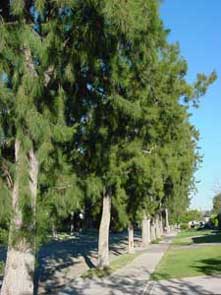 The primary purpose of a study “Quantifying Benefits and Costs of Santa Monica’s Urban Forest” was to find out if the accrued benefits from Santa Monica’s urban forest justify an annual municipal budget that exceeds $1.5 million. Results indicate that the benefits residents obtain from Santa Monica’s urban forest exceed management costs by nearly $1 million. Santa Monica has invested millions of dollars in its municipal forest, and citizens are now receiving a relatively large return on that investment, such as increased property values, enhanced scenic beauty, air pollutant uptake, cooling and heating savings, lower summertime temperatures, and reduced stormwater retention.
The primary purpose of a study “Quantifying Benefits and Costs of Santa Monica’s Urban Forest” was to find out if the accrued benefits from Santa Monica’s urban forest justify an annual municipal budget that exceeds $1.5 million. Results indicate that the benefits residents obtain from Santa Monica’s urban forest exceed management costs by nearly $1 million. Santa Monica has invested millions of dollars in its municipal forest, and citizens are now receiving a relatively large return on that investment, such as increased property values, enhanced scenic beauty, air pollutant uptake, cooling and heating savings, lower summertime temperatures, and reduced stormwater retention.
A study of urban forests in Modesto, CA shows that for each $1 invested in urban forest management, $1.89 in benefits is returned to residents. City trees actually remove 154 tons of air pollutants, increase property values by over $1.5 million, and provide shade that saves over $1 million. This information convinced city officials to increase the tree budget and an electric utility company to invest $20,000 in developing the Modesto Tree Foundation.
From: www.fs.fed.us/psw/programs/uesd/uep/
Interesting Facts
In Milwaukee, where urban trees cover about 16 per cent of the city, trees reduce stormwater flows by 22 per cent. The city saves an estimated $15.4 million by avoiding the construction of additional retention capacity. In Austin, heavy rains make stormwater management a priority issue. Austin’s tree canopy, almost twice that of Milwaukee’s at approximately 30 per cent, reduced stormwater flow by 28 per cent, providing the city with an estimated $122 million in savings (MacDonald, 1996).
Several investigators have documented dramatic (30 – 50%) differences in cooling-energy use between houses on landscaped and un-landscaped sites (Akbari, 2002).
Hurricane Hugo devastated Charleston, South Carolina, in 1989. Little was spared: homes, churches, power lines, and the urban forest were all heavily damaged or destroyed. 200 residents were asked to identify the single most special physical feature of Charleston damaged or destroyed by Hugo. People identified the urban forest more often than any other aspect of Charleston ( i.e. more than churches, historic buildings or homes) (Vigo, 1990).
Computer simulations using standard building and tree configurations for cities across the U.S. indicate that shade from a single well-placed, mature tree (about 25-ft crown diameter) reduces annual air conditioning use 2 to 8 percent and peak cooling demand 2 to 10 percent (Simpson and McPherson, 1996).
A major study of Chicago estimated that trees in that city annually removed 15 metric tons of carbon monoxide, 84 tons of sulfur dioxide, 89 tons of nitrogen dioxide, 191 tons of ozone, and 212 tons of small particulates. The estimated value of this pollution removal was $1 million for trees in the city itself and $9.2 million for the entire Chicago area (Nowak, 1994).
The ambient air temperature difference between an urban heat island and a vegetated area can be as much as 2-10 degrees F. The temperature measured directly above man-made surfaces can be as much as 25 degrees F hotter than the air temperature beneath a forested area (Akbari et. al., 1992; Simpson and McPherson, 1996).
Using the city of Davis, California as a model, existing data on the benefits and costs of municipal trees were applied to the results of a sample inventory of the city’s public and private street trees. Results indicate that Davis maintained nearly 24,000 public street trees that provided $1.2 million in net annual environmental and property value benefits, with a benefit–cost ratio of 3.8:1 (Maco and McPherson, 2003).
From: www.treelink.org
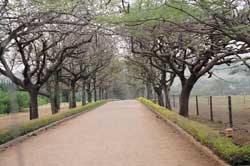
One acre of forest absorbs six tons of carbon dioxide and puts out four tons of oxygen. This is enough to meet the annual needs of 18 people. -U.S. Department of Agriculture
There are about 60-to 200- million spaces along our city streets where trees could be planted. This translates to the potential to absorb 33 million more tons of CO2 every year, and saving $4 billion in energy costs. -National Wildlife Federation
Trees properly placed around buildings can reduce air conditioning needs by 30 percent and can save 20 – 50 percent in energy used for heating. -USDA Forest Service
Trees can be a stimulus to economic development, attracting new business and tourism. Commercial retail areas are more attractive to shoppers, apartments rent more quickly, tenants stay longer, and space in a wooded setting is more valuable to sell or rent. -The National Arbor Day Foundation
The planting of trees means improved water quality, resulting in less runoff and erosion. This allows more recharging of the ground water supply. Wooded areas help prevent the transport of sediment and chemicals into streams. -USDA Forest Service
In laboratory research, visual exposure to settings with trees has produced significant recovery from stress within five minutes, as indicated by changes in blood pressure and muscle tension. -Dr. Roger S. Ulrich Texas A&M University
A tree can grow to manufacture five pounds of pure oxygen per day, consume carbon dioxide to fight the “greenhouse effect” that threatens our survival, and provide the cooling equivalent of ten room-size air conditioning units.
From: http://www.arborday.org/trees/benefits.cfm
LINKS
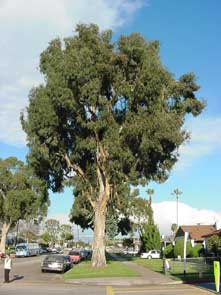 TreeLink: The Urban Forestry Resource –
TreeLink: The Urban Forestry Resource –
www.treelink.org
A fabulous source for information and networking about urban trees that offers a search engine to find specific information from over 2000 resources. It has a fun format with changing tree factoids, tree care tips, a tutorial on applying for grants and a Kid’s Corner.
TreeLink New York –
www.treelink.org/linx/?navLocationRef=33
Center for Urban Forest Research, Pacific Southwest Research Station –
www.fs.fed.us/psw/programs/uesd/uep/
This is the most comprehensive and well-researched web resource. It offers helpful online presentations, Powerpoint presentations and handbooks designed to persuade local elected leaders to value the urban forest. The Center is in the process of developing easy-to-use computer programs to help communities assess the benefits of street trees and help homeowners evaluate the economic trade-offs of different landscape choices.
Sacramento Tree Foundation –
www.sactree.com
Resources, information and news for the Central California region. Offers download of free NeighborWoods Guide handbook. Includes Sacramento Regional Urban Forest Framework for elected leaders with link to helpful Tree Toolkit.
University of Washington, College of Forest Resources, Research Programs –
www.cfr.washington.edu
Lots of hard facts about the financial and social benefits of trees in cities from research projects by Kathleen L. Wolf, Ph.D. This is a good source of ammunition for convincing skeptics who will only look at the bottom line.
Trees New York –
www.treesny.com
News and information specifically for the five boroughs and surrounding region.
Virginia State University, Virginia Cooperative Extension –
pubs.ext.vt.edu/430/430-028/430-028.html
Specific detailed information about landscaping with trees for parking lots and paved areas.
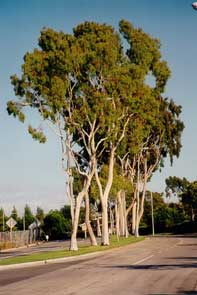 The National Arbor Day Foundation –
The National Arbor Day Foundation –
www.arborday.org
Everything you ever wanted to know about specific trees. Site includes online tree identification guides, great graphic presentations about the benefits of trees, a store for purchasing climate/region specific trees and information about the Tree City USA program. You can even get 10 free trees by joining the National Arbor Day Foundation.
Society of Municipal Arborists –
www.urban-forestry.com/
Browse the online issues of City Trees magazine and check out the helpful list of links.
Colorado Tree Coalition –
www.coloradotrees.org/benefits.htm
Offers detailed articles on benefits of trees.
E: The Environmental Magazine –
www.enn.com/
Article on “Do urban trees really help reduce pollution and clean air?”, Tuesday, August 31, 2004
American Forests.org –
www.americanforests.org/
To add your tree-related link to this page, please email TERRECON, Inc..
All photos on this page were provided by
Walter Warriner
Consulting Arborist